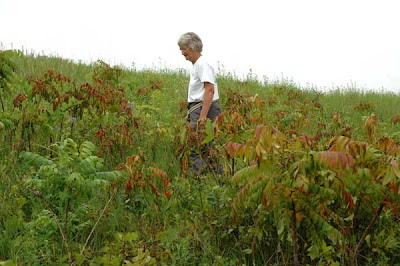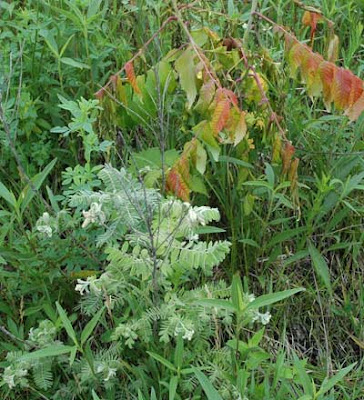Great day for pulling sweet clover!
Today, I got into the act. What a day for pulling sweet clover! After three days of heavy rain, the ground was loose, making pulling easy. Also, the weather was fantastic, cool, breezy, with scattered clouds and low humidity.
 At Rettenmund Prairie, sweet clover is present in large patches scattered here and there across the North Unit. The photo here shows a typical "wall of sweet clover". Not a pleasant sight to contemplate.
At Rettenmund Prairie, sweet clover is present in large patches scattered here and there across the North Unit. The photo here shows a typical "wall of sweet clover". Not a pleasant sight to contemplate.I am using three methods on a patch such as this. The smaller plants, either flowering or not, are pulled with one hand, grabbing the stem very close to the soil surface. Care is taken that the whole root is removed.
The larger plants, with one or two major stems, are pulled with two hands, using a Parsnip Predator shovel to loosen the roots.
The large, multi-stem plants, which are really hard to pull, even with a shovel, are being sprayed (basal bark) with Garlon 4 in oil. I simply pull the plant back to uncover the base, and give each stem a brief spritz. I carry the herbicide in a belt bag. This procedure works well, and damage to adjacent "good" plants does not occur. Sprayed plants show visible damage in about three days.
 The importance of getting the whole roots must be emphasized. Sweet clover forms a very long tap root (see photo), and if the stem is broken or cut above the soil surface, dormant buds in the root collar start to grow and form a new plant, which generally goes on to flower. Such plants generally make seeds, thus contributing to the seed bank and delaying for years the eradication process.
The importance of getting the whole roots must be emphasized. Sweet clover forms a very long tap root (see photo), and if the stem is broken or cut above the soil surface, dormant buds in the root collar start to grow and form a new plant, which generally goes on to flower. Such plants generally make seeds, thus contributing to the seed bank and delaying for years the eradication process.I need to emphasize how quickly sweet clover takes over a natural area. The patch I eradicated is a very high quality prairie remnant that a few weeks ago was full of great plants. The sweet clover plants have been flourishing in the rainy weather we have been having, and were quickly able to produce that "wall of sweet clover" shown above. What happened to all the good plants that had been there? They are still there, but had been doomed if the sweet clover was not removed.
As I pulled the sweet clover, I made a list of prairie plants that were underneath. Without even trying, I listed 27 species that were being suppressed (see the list below). Now they are back in the open and able to continue to grow, flower, and set seed. Obviously, getting rid of sweet clover makes a lot of sense.
| Plants uncovered when removing sweet clover |
| White camas lily |
| Butterfly milkweed |
| Alum root |
| Stiff gentian |
| Black-eyed Susan |
| Rosin weed |
| Flowering spurge |
| Lead plant |
| False solomon's seal |
| Pussy toes |
| Prairie willow |
| Little bluestem |
| Indian grass |
| Northern bedstraw |
| Heath aster |
| Culver's root |
| Bergamot |
| Hawk weed |
| Thimbleweed |
| Yellow cone flower |
| Common milkweed |
| Stiff goldenrod |
| Rattlesnake master |
| Wood betony |
| Prairie cinquefoil |
| Harebell |
| Rough blazing star |









